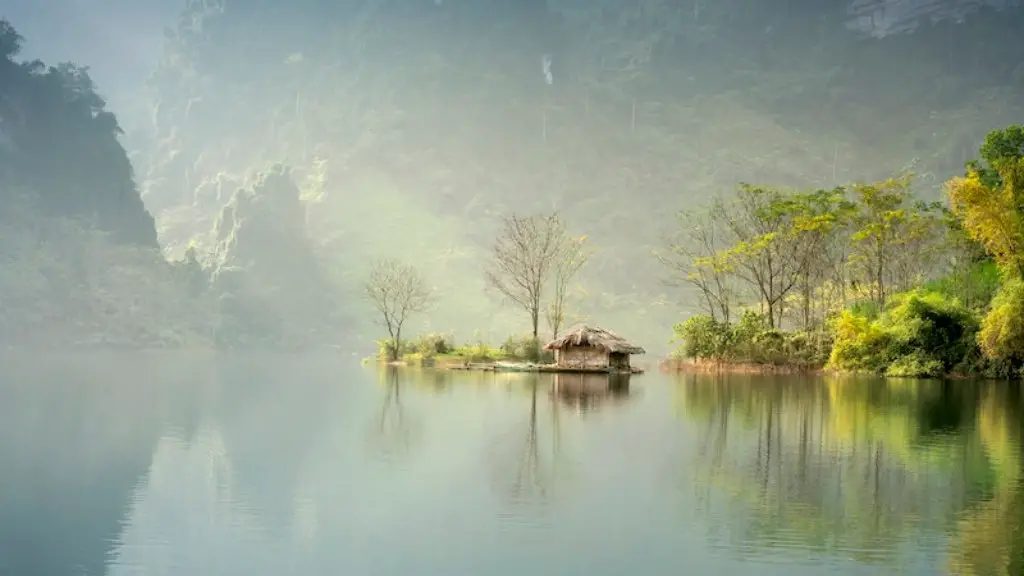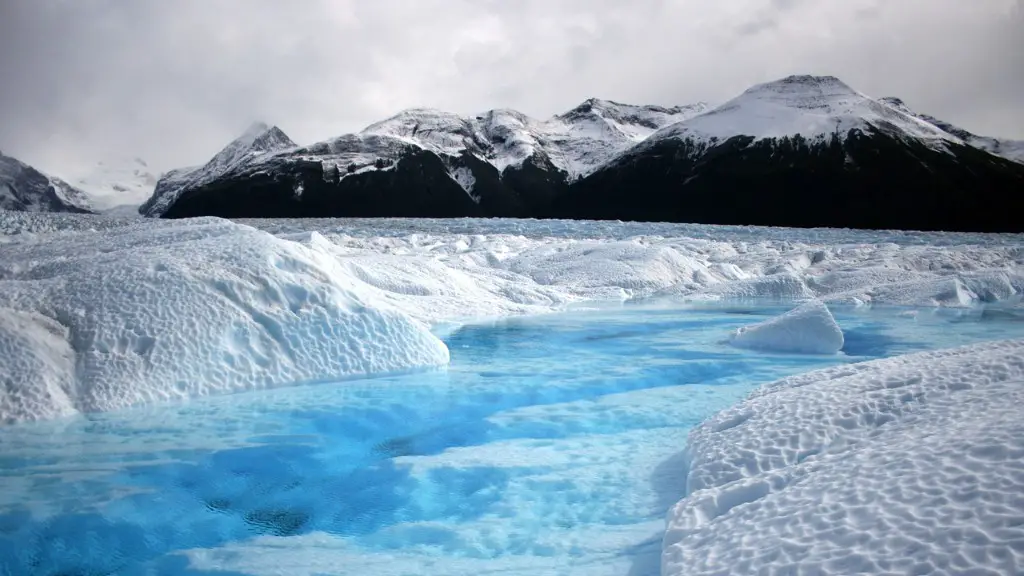The Blue Nile River, located in Ethiopia, is one of the two major tributaries of the Nile River. It originates in Lake Tana, located high in the Ethiopian Highlands and flows northward into Sudan before joining the White Nile near Khartoum, Sudan. The Blue Nile is longer and steeper than the White Nile and contributes significantly more to the Nile River’s flow in Egypt. But while the White Nile originates in Lake Victoria, the Blue Nile begins with a few small streams in Ethiopia that gradually become a major river.
The Blue Nile River is incredibly important to the people of the countries it passes through. It is a major source of drinking and irrigation water, a source of food for humans and animals, and a major means of transportation. The Blue Nile also provides enormous potential for hydropower and irrigation development and supports flourishing fishing, navigation and tourism industries. The Blue Nile experiences two periods of high flow during the rainy season from June to September and during the dry season from October to May.
The Blue Nile is home to a wide variety of life, ranging from small mammals, fish, amphibians, and invertebrates to birds and large mammals. The river also serves as an important refuge for a number of threatened and endangered species such as the African elephant and the white-winged tern.
In recent years, however, the Blue Nile has been threatened by drought, overpopulation, and pollution. These issues have contributed to severe water shortages and food insecurity in Ethiopia, especially in rural areas. This has had a devastating impact on the people and ecosystems of the region, which rely heavily on the Blue Nile for water, food, and livelihoods. Fortunately, Ethiopia and other countries are working together to find solutions to these challenges, as well as strengthen the sustainability of the river for future generations.
Experts in the field have highlighted some measures to be undertaken in order to conserve the Blue Nile such as environmental awareness and education, better management of resources and development, and increased collaboration between the countries sharing the river. They have stressed the need to manage the river carefully in order to avoid the impacts of population growth, climate change and over-exploitation of the natural resources. In addition, they have also recommended the use of sustainable and renewable energy techniques such as solar and wind energy to reduce the use of fossil fuels which can cause pollution and affect the quality of the water.
The most important take-away from any type of discussion about the Blue Nile is that it must be properly managed and conserved for future generations. The preservation of this invaluable waterway is essential to ensure the long-term health and livelihoods of those who depend on it. It is a shared responsibility of the countries sharing the Blue Nile to come together and protect this precious resource.
Fishing & Livelihoods Along the Blue Nile
The Blue Nile is not only a source of life for a variety of species, but also a source of livelihoods for many of the local people. Fishing is the most common livelihood in the region with a large variety species being caught, such as carp, catfish, tilapia, and eel. People living along the banks of the Blue Nile rely heavily on fishing as a source of food and income. In addition to fishing, the people also engage in agriculture as well as livestock, mining and quarrying of minerals, and some services.
The local people not only take advantage of the natural resources, they also contribute to the conservation of the environment. They are aware of the importance of taking care of the river and its habitats in order to ensure the long-term health of the river ecosystem. The local people have implemented various sustainable practices such as the use of net limitation, the creation of fish sanctuaries or the practice of adaptive co-management.
However, there are also challenges for those living along the banks of the Blue Nile. Climate change has caused erratic rainfall patterns and droughts, resulting in a decrease of resources for the local people. Overfishing has also caused serious damage to the river and its resources. In addition, illegal activities such as pollution and hunting are also taking place. These activities put the livelihoods of the local people in danger, as they are dependent on the resources the river provides.
In order to protect and conserve the Blue Nile and its resources, it is essential to invest in research through studies that assess the impacts of climate change and other environmental pressures on the river. It is also necessary to invest in adequately managing and cooperating between the countries sharing the resources.
Environmental Challenges & Solutions
Environmental challenges, such as pollution and water scarcity, are of primary concern on the Blue Nile. Pollution has been caused by industrial and agricultural activities, routine human activities and waste, resulting in the river being unfit for farming, fishing and recreation. Water scarcity has been caused by the increased population, lack of rainfall, over-exploitation of water, and the mismanagement of water resources. These problems have a direct impact on the local people who rely heavily on the river for their livelihoods.
In order to address these issues, Ethiopia has taken steps to ensure a cleaner and healthier environment. The Ethiopian Government has invested in wastewater treatment plants, which treat wastewater before it is discharged back into the river. Additionally, the government has been working to expand water storage and increase the efficiency of water use. They have also implemented educational programs that inform people of the importance of preserving the environmental resources.
International organisations and NGOs, such as the World Bank and the UN have been instrumental in helping the people along the Blue Nile conserve the resources. Through projects such as Sustainable Development and Climate Resilience and Sustainable Management of the Blue Nile Basin, they have provided funding and technical assistance to promote sustainable practices and technologies, such as natural resource conservation, community development, and education and awareness programmes.
It is clear that environmental challenges are a real issue that needs to be addressed in the Blue Nile region. By working together and investing in the initiative to save the river, a better future for the people living along its banks could be secured.
Climate Change & Floods
Climate change is having a profound effect on the Blue Nile environment and has led to increased temperatures, changes in rainfall patterns and increased occurrences of drought and floods. This has had a direct impact on the river’s water levels, the crops, livestock and the livelihoods of the local people, who are already facing environmental problems.
The Ethiopian Government, international organisations and NGO’s have taken steps to help prepare for and adapt to the impacts of climate change along the Blue Nile. They have identified strategies such as capacity building and knowledge sharing amongst communities, implementation of mitigation strategies to reduce greenhouse gas emissions, and implementation of adaptation strategies to deal with the climate change impacts.
In addition, the Ethiopian Government has also set up a Climate Change Commission that is responsible for managing and addressing the impacts of climate change in the country. The commission works closely with the Ministry of Water, Irrigation, and Energy to ensure efficient, water-smart agriculture and improved water resource management.
It is clear that climate change will have an immense impact on the Blue Nile, which is why proactive and effective measures need to be taken to address the problem. It is a shared responsibility between the countries sharing the river to ensure the long-term health of the river.
Infrastructure Along the Blue Nile
The Blue Nile River is an important economic arterial providing transportation and energy. A number of dams have been built along the course of the river in order to harness the river’s potential for power generation. These dams provide electricity for millions of people and also play a crucial role in flood control and drought mitigation.
The Ethiopian Government is investing heavily in infrastructure along the Blue Nile in order to improve the river’s navigability for transport and reap the benefits of electricity generation. This includes projects such as the Daga Dam, which is set to be the largest hydroelectric dam in Africa, as well as a number of road and bridge projects.
The projects are aimed at promoting regional economic integration and increasing access to markets, energy and services. They are also intended to increase the efficiency of transportation along the river, improve access to finance and investment, and reduce poverty in the region.
The Ethiopian Government has also established an integrated transport network, labeled the “Blue Nile Waterway”, which runs from the northern border of Ethiopia to the Sudanese border. This network is intended to support activities such as bridge and road construction and facilitate the exchange of goods and services. These projects are expected to have a significant impact on the economic development of the region.
It is clear that infrastructural improvements will have a positive impact on the people living along the Blue Nile. With the right infrastructure and investment, the people could have better access to markets and energy, as well as improved economic prospects.
Impact On Education & Health
The Blue Nile plays a vital role in the development of Ethiopia, with a number of projects being undertaken in order to improve educational and health outcomes of the people living in the region. Investments have been made in interventions such as teacher training, improvements to educational facilities and medical infrastructure. This has had a positive effect on the educational attainment and health status of the population.
The Ethiopian Government has established a number of programs to improve access to education in the region, such as the Support for Technical and Vocational Education and Training (TVET) program, the Basic Education improvement and Learning Achievement program, and the Early Childhood Education program. In addition, the Ethiopian Government is using technology to increase access to education and health information in the region. This has contributed to a significant increase in school enrolment and health outcomes in the region.
The government is also taking measures to improve access to safe drinking water in the region. This has resulted in a decrease in water-borne illnesses and has reduced water-borne infections, leading to an improvement in the health of the population.
It is clear that improved educational outcomes and health services have had a positive impact on the general population living along the Blue Nile. By investing in and improving access to education and healthcare, the people in the region have been given the opportunity to better their lives.





